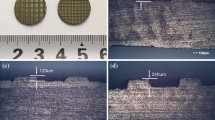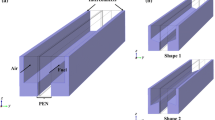Abstract
For the anode-supported solid oxide fuel cells (SOFC), the relatively thin cathode limits the oxygen transfer in-plane. In order to enhance the oxygen transfer in-plane, the interconnector with sinusoidal wavy channel is proposed for SOFC, termed the sinusoidal wavy interconnector (SWI). The effect of SWI is evaluated by numerical method. The oxygen transfer in-plane is promoted, especially at trough position, where the rib width is minimum. For SWI, the maximum oxygen concentration achieves 0.21 mol/m3 on the center line of the cathode/electrolyte interface, which is almost zero for the conventional interconnector. Finally, the effect of amplitude and cycle number on SOFC performance is investigated in detail. The result shows that the average oxygen concentration enhances with the increase of amplitude (A) and cycle number (Pe). When A is 0.4 mm, the average oxygen concentration is 1.51 mol/m3, an increase of 14.39 % from the conventional interconnector (A = 0 mm) of 1.32 mol/m3. In addition, for A = 0.25 mm, the average oxygen on the cathode/electrolyte interface is improved by 18% when Pe increases from 0 to 16. On the other hand, if the amplitude or cycle number is too large, the hindrance caused by the undulating side surface of SWI results in remarkable power consumption. Hence, when cycle number is 16, the effective power achieves the maximum at A = 0.35 mm, which increases by 18.3% compared to the conventional interconnector (A = 0).














Similar content being viewed by others
Abbreviations
- A cell :
-
Cross-section area of cell (m2)
- \({A}_{ch}^{ca}\) :
-
Cross-section area of air channel (m2)
- \({A}_{ch}^{an}\) :
-
Cross-section area of fuel channel (m2)
- ASR contact :
-
Contact resistance (Ωcm2)
- B 0 :
-
Permeability coefficient (m2)
- c i0 :
-
Molar concentration of species i at channel inlet (mol/m3)
- C i :
-
Molar concentration of species i (mol/m3)
- C p :
-
Specific heat capacity (J/kg)
- D ij :
-
Binary diffusion coefficient (m2/s)
- D iKn :
-
Knudsen diffusion coefficient of species i (m2/s)
- D i :
-
Equivalent diffusion coefficient of speciesi (m2/s)
- E 0 :
-
Nernst potential (V)
- E out :
-
Output power (W)
- E eff :
-
Effective power (W)
- F :
-
Faraday constant (96,487 C/mol)
- i el :
-
Electronic current density (A/m2)
- i io :
-
Ionic current density (A/m2)
- \({i}_{trans}^{an}\) :
-
Local transfer current at anode (A)
- \({i}_{trans}^{ca}\) :
-
Local transfer current at cathode (A)
- K eff :
-
Thermal conductivity (W/(m.K))
- M i :
-
Molecular mass (kg/mol)
- N i :
-
Molar flux (mol/m2/s)
- R :
-
Universal gas constant (J/mol/K)
- p :
-
Total pressure (Pa)
- p 0 :
-
One atmospheric pressure (Pa)
- \({p}_i^0\) :
-
Species i pressure at channel inlet (Pa)
- \({p}_i^{TPB}\) :
-
Species i pressure at TPB (Pa)
- Q ohm :
-
Ohmic heat source (W/m3)
- Q act :
-
Active heat source (W/m3)
- Q entr :
-
Entropy heat source (W/m3)
- r g :
-
Pore radii (m)
- T :
-
Operating temperature (K)
- T ref :
-
Reference temperature (K)
- u :
-
Convection velocity (m/s)
- ν i :
-
Diffusion volume (m3/mol)
- x i :
-
Molar fraction
- Φel :
-
Local electronic potential (V)
- Φio :
-
Local ionic potential (V)
- V op :
-
Operational potential (V)
- \({\sigma}_{el}^{eff}\) :
-
Effective conductivity (S/m)
- \({\eta}_{act}^{an}\) :
-
Anode activation polarization (V)
- \({\eta}_{act}^{ca}\) :
-
Cathode activation polarization (V)
- ε :
-
The porosity
- μ :
-
Viscosity coefficient of fluid (Pa·s)
- ρ :
-
Density (kg/m3)
- τ :
-
Tortuosity factor
References
Zhang Y, Zhang X, Ni J, Ni C (2023) Pr-doped SrTi0.5Mn0.5O3−δ as an electrode material for a quasi-symmetrical solid oxide fuel cell using methane and propane fuel. ACS Appl Mater Interfaces 15:3974–3984. https://doi.org/10.1021/acsami.2c18530
Chen H et al (2022) Numerical study on charge transport and electrochemical performance of Gd and Pr co-doped ceria-based solid oxide fuel cells free from internal shorting. Ionics 28:3445–3452. https://doi.org/10.1007/s11581-022-04563-x
Kong W, Han Z, Lu S, Ni M (2021) A simple but effective design to enhance the performance and durability of direct carbon solid oxide fuel cells. Appl Energy 287. https://doi.org/10.1016/j.apenergy.2021.116586
Shi H, Su C, Ran R, Cao J, Shao Z (2020) Electrolyte materials for intermediate-temperature solid oxide fuel cells. Progress in Natural Science: Materials International 30:764–774. https://doi.org/10.1016/j.pnsc.2020.09.003
Dai JQ et al (2022) Study the flow and species distribution characteristics in a typical 25-cell proton ceramic fuel cell stack by 3D large-scale modeling. Ionics 28:1863–1872. https://doi.org/10.1007/s11581-022-04465-y
Yu N et al (2022) Co-generation of liquid chemicals and electricity over Co-Fe alloy/ perovskite anode catalyst in a propane fueled solid oxide fuel cell. Sep Purif Technol 291:120890. https://doi.org/10.1016/j.seppur.2022.120890
Akenteng YD et al (2022) Computational fluid dynamics modeling of an inter-parallel flow field for proton ceramic fuel cell stack. Ionics 28:3367–3378. https://doi.org/10.1007/s11581-022-04577-5
Huang H et al (2020) The analysis of structure parameters of MOLB type solid oxide fuel cell. Int J Hydrogen Energy 45:20351–20359. https://doi.org/10.1016/j.ijhydene.2019.10.251
Kong W, Gao X, Liu S, Su S, Chen D (2014) Optimization of the interconnect ribs for a cathode-supported solid oxide fuel cell. Energies 7:295–313. https://doi.org/10.3390/en7010295
Lu S, Zhang M, Wu J, Kong W (2022) Performance investigation on mono-block-layer build type solid oxide fuel cells with a vertical rib design. Energies 15:979. https://doi.org/10.3390/en15030979
Guo M, Lin Z (2021) Long-term evolution of mechanical performance of solid oxide fuel cell stack and the underlying mechanism. Int J Hydrogen Energy 46:24293–24304. https://doi.org/10.1016/j.ijhydene.2021.04.196
Wang Y et al (2022) Assessing performance degradation induced by thermal cycling in solid oxide cells. Energ Conver Manage 270. https://doi.org/10.1016/j.enconman.2022.116239
Wang Y et al (2022) Coupling deep learning and multi-objective genetic algorithms to achieve high performance and durability of direct internal reforming solid oxide fuel cell. Appl Energy 315. https://doi.org/10.1016/j.apenergy.2022.119046
Wang Y et al (2023) Boosting the performance and durability of heterogeneous electrodes for solid oxide electrochemical cells utilizing a data-driven powder-to-power framework. Sci Bull (Beijing) 68: 516-527. https://doi.org/10.1016/j.scib.2023.02.019
Xiong X, Liang K, Ma G, Ba L (2023) Three-dimensional multi-physics modelling and structural optimization of SOFC large-scale stack and stack tower. Int J Hydrogen Energy 48:2742–2761. https://doi.org/10.1016/j.ijhydene.2022.10.146
Papurello D, Canuto D, Santarelli M (2022) CFD model for tubular SOFC stack fed directly by biomass. Int J Hydrogen Energy 47:6860–6872. https://doi.org/10.1016/j.ijhydene.2021.12.015
Lin Z, Stevenson JW, Khaleel MA (2003) The effect of interconnect rib size on the fuel cell concentration polarization in planar SOFCs. J Power Sources 117:92–97. https://doi.org/10.1016/s0378-7753(02)00726-7
Liu S, Song C, Lin Z (2008) The effects of the interconnect rib contact resistance on the performance of planar solid oxide fuel cell stack and the rib design optimization. J Power Sources 183:214–225. https://doi.org/10.1016/j.jpowsour.2008.04.054
Kong W, Li J, Liu S, Lin Z (2012) The influence of interconnect ribs on the performance of planar solid oxide fuel cell and formulae for optimal rib sizes. J Power Sources 204:106–115
Zeng S, Zhang X, Song Chen J, Li T, Andersson M (2018) Modeling of solid oxide fuel cells with optimized interconnect designs. International Journal of Heat and Mass Transfer 125:506–514. https://doi.org/10.1016/j.ijheatmasstransfer.2018.04.096
Li, X., Shi, W. & Han, M. (2018) Optimization of interconnect flow channels width in a planar solid oxide fuel cell. Int J Hydrogen Energy 43: 21524-21534, https://doi.org/ 10.1016/j.ijhydene.2018.09.061.
Li PW, Chen SP, Chyu MK (2006) To achieve the best performance through optimization of gas delivery and current collection in solid oxide fuel cells. J Fuel Cell Sci Technol 3:188–194. https://doi.org/10.1115/1.2174068
Chen Q, Wang Q, Zhang J, Yuan J (2011) Effect of bi-layer interconnector design on mass transfer performance in porous anode of solid oxide fuel cells. International Journal of Heat and Mass Transfer 54:1994–2003. https://doi.org/10.1016/j.ijheatmasstransfer.2011.01.003
Yan M, Fu P, Li X, Zeng M, Wang Q (2015) Mass transfer enhancement of a spiral-like interconnector for planar solid oxide fuel cells. Appl Energy 160:954–964. https://doi.org/10.1016/j.apenergy.2015.03.115
Bhattacharya D, Mukhopadhyay J, Biswas N, Basu RN, Das PK (2018) Performance evaluation of different bipolar plate designs of 3D planar anode-supported SOFCs. International Journal of Heat and Mass Transfer 123:382–396. https://doi.org/10.1016/j.ijheatmasstransfer.2018.02.096
Kong W, Han Z, Lu S, Gao X, Wang X (2020) A novel interconnector design of SOFC. Int J Hydrogen Energy 45:20329–20338. https://doi.org/10.1016/j.ijhydene.2019.10.252
Zhan R et al (2020) Three-dimensional simulation of solid oxide fuel cell with metal foam as cathode flow distributor. Int J Hydrogen Energy 45:6897–6911. https://doi.org/10.1016/j.ijhydene.2019.11.221
Fu Q et al (2021) Performance enhancement of planar solid oxide fuel cell using a novel interconnector design. Int J Hydrogen Energy 46:21634–21656. https://doi.org/10.1016/j.ijhydene.2021.04.001
Fu Q et al (2021) Performance enhancement of a beam and slot interconnector for anode-supported SOFC stack. Energ Conver Manage 241:114277. https://doi.org/10.1016/j.enconman.2021
Wang Y et al (2020) Three-dimensional modeling and performance optimization of proton conducting solid oxide electrolysis cell▴. Fuel Cells 20:701–711. https://doi.org/10.1002/fuce.201900246
Guo M, He Q, Cheng C, Zhao D, Ni M (2022) New interconnector designs for electrical performance enhancement of solid oxide fuel cells: a 3D modelling study. J Power Sources 533:231373. https://doi.org/10.1016/j.jpowsour.2022.231373
Cai G, Liang Y, Liu Z, Liu W (2020) Design and optimization of bio-inspired wave-like channel for a PEM fuel cell applying genetic algorithm. Energy 192:116670. https://doi.org/10.1016/j.energy.2019
Chen X et al (2021) Performance investigation on a novel 3D wave flow channel design for PEMFC. Int J Hydrogen Energy 46:11127–11139. https://doi.org/10.1016/j.ijhydene.2020.06.057
Kuo J-K, Chen C, o.-K. (2006) Evaluating the enhanced performance of a novel wave-like form gas flow channel in the PEMFC using the field synergy principle. J Power Sources 162:1122–1129. https://doi.org/10.1016/j.jpowsour.2006.07.053
Kuo J-K, Yen T-H, Chen C, o.-K. (2008) Three-dimensional numerical analysis of PEM fuel cells with straight and wave-like gas flow fields channels. J Power Sources 177:96–103. https://doi.org/10.1016/j.jpowsour.2007.11.065
Su S, Gao X, Zhang Q, Kong W, Chen D (2015) Anode- versus cathode-supported solid oxide fuel cell: effectof cell design on the stack performance. Int J Electrochem Sci 10:2487–2503
Su S, Zhang Q, Gao X, Periasamy V, Kong W (2016) Effects of changes in solid oxide fuel cell electrode thickness on ohmic and concentration polarizations. Int J Hydrogen Energy 41:16181–16190. https://doi.org/10.1016/j.ijhydene.2016.04.221
Costamagna P, Honegger K (1998) Modeling of solid oxide heat exchanger integrated stacks and simulation at high fuel utilization. J Electrochem Soc 145:3995–4006
Barzi YM, Raoufi A, Lari H (2010) Performance analysis of a SOFC button cell using a CFD model. Int J Hydrogen Energy 35:9468–9478. https://doi.org/10.1016/j.ijhydene.2010.05.086
Sanyal J, Goldin GM, Zhu H, Kee RJ (2010) A particle-based model for predicting the effective conductivities of composite electrodes. J Power Sources 195:6671–6679
Khazaee I, Rava A (2017) Numerical simulation of the performance of solid oxide fuel cell with different flow channel geometries. Energy 119:235–244. https://doi.org/10.1016/j.energy.2016.12.074
Funding
This work was financially supported by the National Science Foundation of China (22179054).
Author information
Authors and Affiliations
Corresponding author
Additional information
Publisher’s note
Springer Nature remains neutral with regard to jurisdictional claims in published maps and institutional affiliations.
Rights and permissions
Springer Nature or its licensor (e.g. a society or other partner) holds exclusive rights to this article under a publishing agreement with the author(s) or other rightsholder(s); author self-archiving of the accepted manuscript version of this article is solely governed by the terms of such publishing agreement and applicable law.
About this article
Cite this article
Liu, J., Shao, H., Kong, W. et al. A novel sinusoidal wavy interconnector for improved performance of SOFC. Ionics 29, 2393–2403 (2023). https://doi.org/10.1007/s11581-023-04972-6
Received:
Revised:
Accepted:
Published:
Issue Date:
DOI: https://doi.org/10.1007/s11581-023-04972-6




